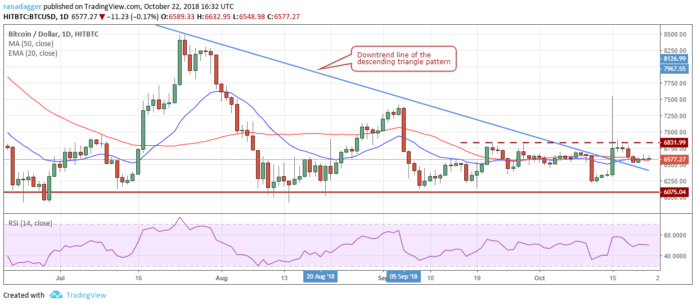
The views and opinions expressed here are solely those of the author and do not necessarily reflect the views of Cointelegraph. Every investment and trading move involves risk, you should conduct your own research when making a decision.
Market data is provided by the HitBTC exchange.
The Financial Action Task Force (FATF), a global anti-money laundering (AML) supervisory body, will set up rules to monitor cryptocurrencies by June of next year. This is a welcome step that will create uniform regulations and reduce the use of virtual currencies for money laundering and terrorism financing.
In 2017 and in early 2018, Bitcoin’s volatility was a hot topic. It was cited as one of the key deterrents in the mass adoption of cryptocurrencies. Fast forward to the last quarter of 2018, and the 20-day historical volatility (HV) of Bitcoin has fallen to 31.5 percent, below that of top stocks like Amazon, Netflix, and Nvidia Corp, whose HV is 35 percent, 52 percent, and 40 percent respectively.
Is this the new normal or just the calm before the storm? Only time can answer that. Let’s study the charts and identify the key levels that will determine whether the cryptocurrencies will continue their downfall or enter a trend reversal.
BTC/USD
Bitcoin dipped below the moving averages on Oct. 19, but the bears could not capitalize on the fall, as the price climbed back up the next day. The 20-day EMA is flat while the 50-day SMA is gradually sloping down. The RSI is at the midpoint. All the indicators and the price action suggest a state of equilibrium between the buyers and the sellers.
If the bears break below $6,500, the fall can extend to $6,200. The critical level on the downside is the support zone of $5,900–$6,075.04. If this breaks, we anticipate panic selling that can result in a steep decline.
On the upside, a break out of $6,831.99 will attract buying and force the short sellers to cover their positions, propelling the BTC/USD pair to $7,400.
Volumes have dropped and there is no confident trading either from the bulls or the bears. We have to wait for either party to make a decisive move. Until then, sluggish, range bound action is likely to continue. Traders who own long positions can keep a protective stop at $5,900.
ETH/USD
Ethereum continues to trade below both moving averages, which is a negative sign. It can now slide to the first support at $192.5, below which a retest of the Sept. 12 low of $167.32 is probable.

On the upside, if the ETH/USD pair breaks out of the moving averages, it can reach the top of the $192.5–$249.93 range.
The digital currency will become positive if it can scale $250. If the bulls sustain above the range, a rally to $322 is probable. We can’t find any setups as long as the price remains inside the range.
XRP/USD
The bears have successfully defended the 20-day EMA for the past four days. Ripple can now correct to the 50-day SMA, which might act as a support.

If the bears break below the 50-day SMA, the XRP/USD pair can drop to $0.37185. On the upside, a break and close (UTC time frame) above the 20-day EMA can carry prices to $0.5, $0.55, and further to $0.625.
We couldn’t find any reliable buy setups at the current levels, hence we are not suggesting any trades in the pair.
BCH/USD
Bitcoin Cash is struggling to bounce off the support line of the symmetrical triangle. The price has failed to rise above the 20-day EMA, which is a bearish sign. Both moving averages are sloping down and the RSI is also in the negative territory. This shows that the bears have an upper hand.

A break down of the triangle and the Sept. 11 intraday low of $408.0182 will resume the downtrend, pushing the price to the next support at $300. Therefore, traders can keep a stop loss at $400 on their existing long positions. The BCH/USD pair will show signs of a pullback if it breaks out of the triangle.
EOS/USD
EOS has been stuck close to $5.5 for the past six days. Both moving averages are flat and the RSI is close to the neutral territory. This shows that the consolidation might continue for a few more days.

The EOS/USD pair will indicate a trend reversal if it breaks out of $6.8299. If the price sustains above the range, a rally to $9 is probable.
On the downside, if the bears break down of $4.4930, a retest of $3.8723 will be on the cards. The traders can protect their long positions with a stop loss at $4.9.
XLM/USD
Stellar has been trading close to the downtrend line of the descending triangle for the past four days but has failed to break out out it. Currently, it is trading above both moving averages, which are sloping up. This is a positive sign.

A break out of the triangle can propel the XLM/USD pair to $0.36, with a minor resistance at $0.3. Therefore, the traders can initiate a long position on a close (UTC time frame) above $0.27, which is just above the intraday high of Oct. 15.
If the bears defend the downtrend line and sink the price below the moving averages, the digital currency can slide to the lower support zone of $0.184–$0.2.
LTC/USD
Litecoin has been gradually sliding towards the bottom of the range of $49.466–$69.279. Both moving averages are sloping down and the RSI is in the negative territory, which is a bearish sign.

A break down of the range will resume the downtrend and can plunge the LTC/USD pair to the next lower support at $40.
The virtual currency will show first signs of a trend reversal if it breaks out of $69.279 and sustains above it. Following the breakout, the price can rally to the next overhead resistance at $94. The traders should wait for a confirmed breakout before initiating any long positions.
ADA/USD
Both moving averages and the price of Cardano are bunched close to each other with hardly any movement in the past three days. The virtual currency is stuck in a large range of $0.060105–$0.094256.

If the bulls push the price above the moving averages and $0.083, a rally to the overhead resistance of $0.094256 is probable.
On the downside, a break below $0.069 can sink the pair to the critical support of $0.060105. With the ADA/USD pair trading close to the midpoint of the range, we couldn’t find any reliable buy setups at the current levels.
XMR/USD
Monero has held the $104 mark for the past four days and is currently attempting to climb above the 20-day EMA. If it rises above both moving averages, it can move up to $128.65.

If the XMR/USD pair rebounds from the 20-day EMA, it can slide to $100, which will act as a strong support, as this level has held on two previous occasions. The flattening moving averages point to a consolidation. However, if the bears break below $100, a drop to $81 is likely.
TRX/USD
TRON continues to trade near the 20-day EMA. The intraday range has shrunk dramatically in the past three days, which shows a lack of both buying and selling interest among the market participants.

The TRX/USD pair will make its next move after it breaks out and sustains above the top of the current range of $0.0183–$0.02815521. As the cryptocurrency has been trading inside this range for more than two months, we anticipate the breakout to carry it to the next overhead resistance of $0.04158193. The traders can buy on a close (UTC time frame) above $0.03, keeping the initial stop loss at $0.02.
If the bears push the price below the support of $0.0183, the next target on the downside is $0.00844479.
Market data is provided by the HitBTC exchange. Charts for analysis are provided by TradingView.

Cointelegraph.com is author of this content, TheBitcoinNews.com is is not responsible for the content of external sites.
Our Social Networks: Facebook Instagram Pinterest Reddit Telegram Twitter Youtube










